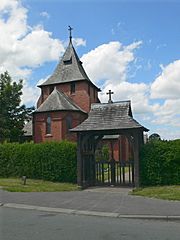All Saints Church, Higher Kinnerton facts for kids
Quick facts for kids All Saints Church, Higher Kinnerton |
|
|---|---|

All Saints Church, Higher Kinnerton
|
|
| 53°08′38″N 3°00′16″W / 53.1439°N 3.0044°W | |
| OS grid reference | SJ 329 611 |
| Location | Main Road, Higher Kinnerton, Flintshire |
| Country | Wales |
| Denomination | Anglican |
| History | |
| Status | Parish church |
| Architecture | |
| Functional status | Active |
| Architect(s) | Douglas and Fordham |
| Architectural type | Church |
| Completed | 1893 |
| Specifications | |
| Materials | Ruabon brick |
| Administration | |
| Parish | Dodleston |
| Deanery | Chester |
| Archdeaconry | Chester |
| Diocese | Chester |
| Province | York |
All Saints Church is a special building located on Main Road in Higher Kinnerton, Flintshire, Wales. It is a church that is still actively used today. It belongs to the Anglican faith, which is a type of Christian church.
This church is part of the Diocese of Chester, which is like a large area managed by a bishop. It also belongs to smaller groups called the archdeaconry of Chester and the deanery of Chester.
Building the Church
The church was designed by a famous team of architects named Douglas and Fordham. They finished building it in 1893. The church is made from a special type of red brick called Ruabon brick, which comes from Wales.
The church has a tall, pointed roof called a spire in the middle. There is also another spire, shaped like a pyramid, above the front part of the church where the altar is. This part is called the chancel.
In 2007, work began on adding a new part to the church building. This new section is now complete. It gives the church useful spaces like a small kitchen, which helps with events and activities.
The Church Organ
All Saints Church has a pipe organ, which is a large musical instrument. It was built by a company called Hardy of Stockport. The sound of the organ was designed by a person named Robert Hope-Jones. Many people believe this was the very first organ that Hope-Jones ever designed.
When it was first built, the organ had a special sound called a Tuba Mirabilis. This is a very powerful sound, and it was unusual for such a small organ to have it. However, in the 1980s, this Tuba Mirabilis part was taken out. It was replaced with a different sound called an Oboe stop, which sounds more like an oboe instrument.
Hope-Jones had a unique idea for this organ. He planned for it to have a special control called a Great to Swell 2nd Touch coupler. This would have allowed the organist to play two different sets of pipes at once with a special touch. There is still a knob for this on the organ's control panel, called the console, but it seems it was never actually connected to work.
See also

